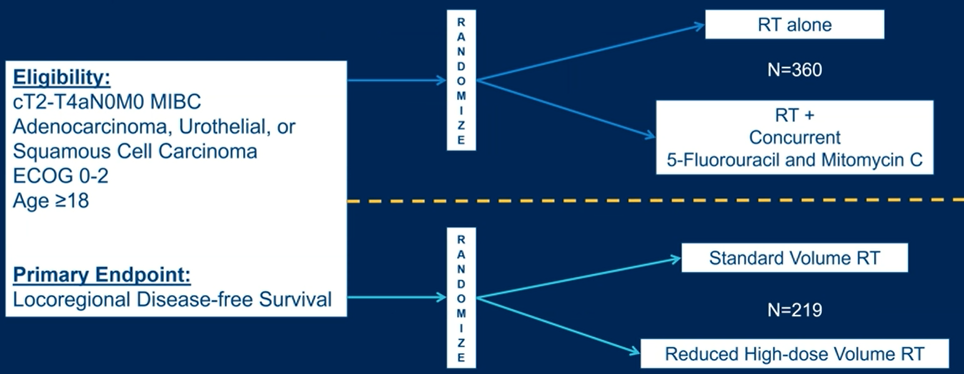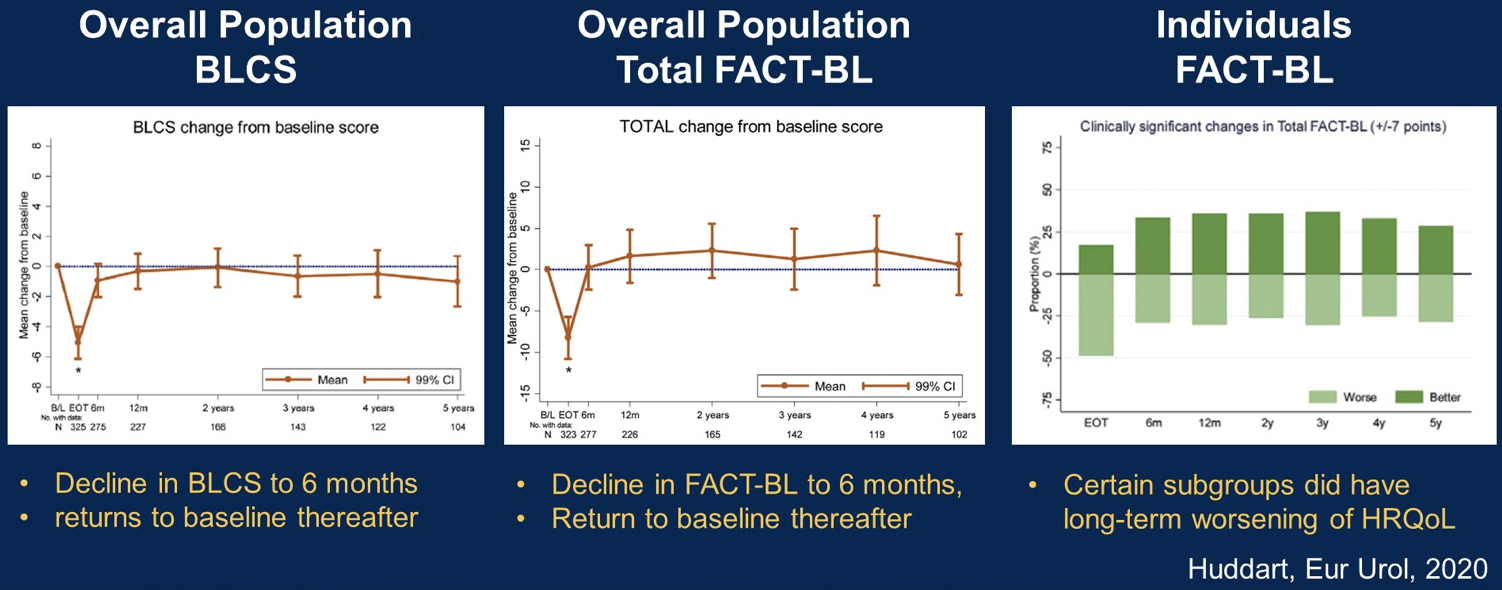1. Trimodal therapy for bladder cancer, and the resulting quality of life
2. Evolutions in radiotherapy (RT) for bladder cancer including adaptive RT and intensity-modulated RT
3. Increasing access to local therapy due to advances in technology
4. The role of stereotactic body radiotherapy in patients with oligometastatic disease
Addressing the first of these, Dr. Solanki emphasized the BC2001 study examining two related questions: first, the role of concurrent chemotherapy with radiotherapy, and second, radiotherapy volumes. \
\
Oncologic outcomes of this trial have clearly demonstrated that for both locoregional disease-free survival and overall survival, the addition of chemotherapy to radiotherapy confers a benefit, though this was not statistically significant with respect to overall survival.
More recently, Huddard and colleagues published patient-reported outcomes assessing the quality of life among patients in the BC2001 trial. Among 458 eligible patients, the authors assess the chance in the bladder cancer subscale (BLCS) of the FACT-BL from baseline to 1 year.
These results demonstrate an acute decline in health-related quality of life in the first 6 months with a return to baseline by 1 year following treatment. On an individual level, a subset of the population has persistently worse quality of life.
Thus, moving forward, it will be valuable to pre-emptively identify these patients and undertake strategies to mitigate these effects.
Dr. Solanki then moved to discuss the second paper, examining technological changes in radiotherapy for bladder cancer. Historically, classic four-field box techniques were associated with a large radiotherapy field with significant radiotherapy to normal tissues and an inability to account for changes in bladder filling. However, more recently, the use of image-guided and intensity-modulated radiotherapy has allowed daily image guidance to allow for accurate targeting. However, to date, there has been little direct data for intensity-modulated RT in bladder cancer.
The second technological advancement is adaptive radiotherapy, to accommodate changes in anatomy from day to day. This approach both ensures treatment of the tumor and reduces overtreatment of the bowel. In the second highlighted study, the HYBRID trial, patients were randomized to standard radiotherapy or “plan of the day” adaptive radiotherapy.
This approach was particularly developed for use in elderly and frail patients who are unable to attend conventionally fractionated radiotherapy regimes. Use of the adaptive RT approach was associated with approximately half the rate of acute non-GU grade 3 or greater toxicity, without meaningful differences in late toxicity, local control, health-related quality of life, or median survival. Notably, the adaptive approach avoiding an acute decline in bowel-related quality of life associated with the conventional approach.
The third cited study is the single-arm, Phase II IMPART trial examining the role of pelvic nodal and bladder intensity-modulated RT in patients with node-positive, but otherwise non-metastatic, muscle-invasive bladder cancer.
This was a previously unstudied patient population in bladder cancer. Notably, in this trial, the use of chemotherapy was at the treating physician’s discretion. While only 38 patients were enrolled, the study demonstrated 5-year pelvic recurrence-free survival of 26%, distant metastasis-free survival of 31%, bladder cancer-specific survival of 44%, and overall survival of 34%. These data provide what Dr. Solanki feels is some of the best data for the use of trimodal therapy in patients with nodal disease. However, there is an ongoing need to improve outcomes for these patients. As such, he highlighted the ongoing ECOG/NRG 8185 trial looking at the addition of durvalumab to chemoradiotherapy following initial induction chemotherapy.
Finally, Dr. Solanki discussed the role of stereotactic body radiation therapy (SBRT) in urothelial cancer. He first mentioned the SABR-COMET study, the STOMP study, and the ORIOLE study including patients with various primary tumors, prostate cancer, and prostate cancer, respectively. Each of these smaller Phase II studies demonstrated promising outcomes. The fourth study highlighted was an observational cohort study of patients treated with SBRT to 1-5 metastases from urothelial carcinoma with a controlled primary tumor. Two-year local control was 89%, distant progression-free survival was 43% and overall survival was 38%. These outcomes were similar to SBRT to oligometastatic disease in other disease sites. However, patients with a higher number of lines of systemic therapy had worse outcomes, suggesting a differing underlying biology.
Presented by: Abhishek Solanki, MD, Associate Professor, Department of Radiology, Quality Medical Director, Radiation Oncology, Loyola University, Chicago, Illinois
Written by: Christopher J.D. Wallis, MD, PhD, Urologic Oncology Fellow, Vanderbilt University Medical Center, Nashville, Tennessee, Twitter: @WallisCJD during the 2021 ASCO Genitourinary Cancers Symposium (ASCO GU), February 11th to 13th, 2021


